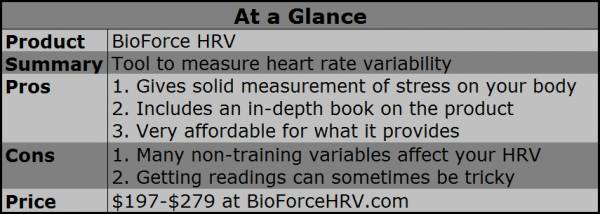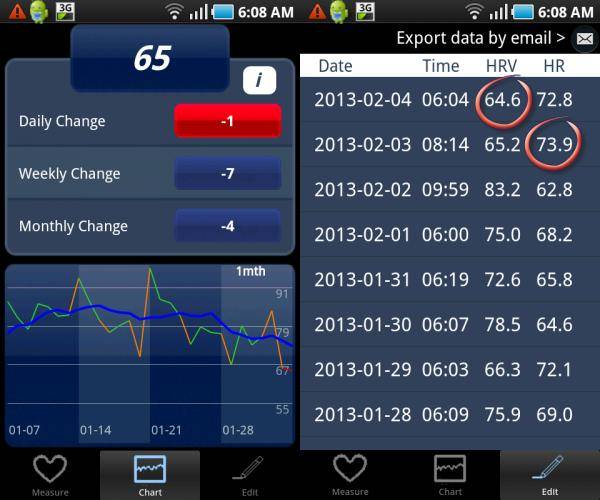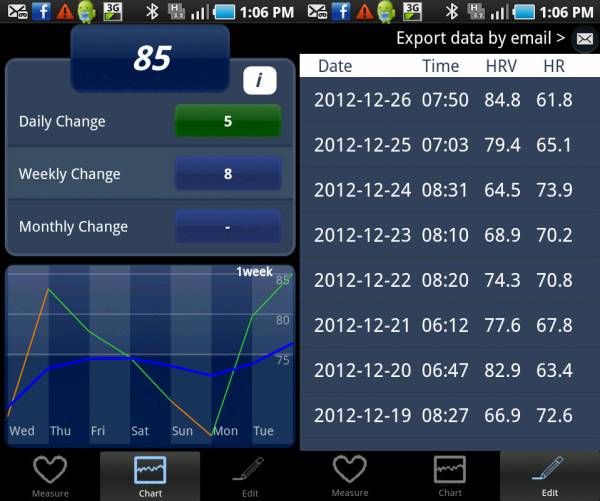
When it comes to training, athletes who care about performance know that small details matter. You probably know people who track a million things about their training, from heart rate to carb grams. One of the newest things you can track is your heart rate variability (HRV). And, as it turns out, it might be just as relevant for fitness newcomers as it is for veterans.
The BioForce HRV system is a device used to measure the variability in the rhythm of your heartbeat that results from training and recovery. The system includes an app that you download and a transmitter you plug into your phone. You may also purchase a Polar heart rate monitor from the BioForce website or use any variety of heart rate strap that you already own.

The BioForce HRV system is not the only HRV monitor on the market, but the app is propriety, so the readings you get from one system compared to another could vary. All the different systems are doing the same thing in essence, though – measuring the space between your heartbeats and tracking changes. According to Joel Jamieson, the creator of the BioForce system, too much change in HRV, either positive or negative, can be indicative of accumulating fatigue.
Ideally, you take your HRV reading every day at the same time. It is recommended to do so right after you get up. Basically, you get out of bed, put on the strap and open the app, then lay supine for two to five minutes before taking your reading. You need to be in a relaxed state. My experience was that the app errored out more than I wanted it to while I was trying to get a reading, but the book’s troubleshooting section does address this issue.
Since HRV numbers are relative to each person, at first the app doesn’t have any idea who you are or what a normal HRV is for you. It will take a few days to establish a baseline, during which you should do light exercise or active recovery. After that time period you can resume regular training. Each morning when you take your reading, the app will give you a number and will be colored green, yellow, or red based on the difference from the previous day’s reading. Like a traffic light, these colors indicate go, caution, or stop.
One thing that needs to be noted is that the BioForce HRV system tracks your number. It does not interpret your number. This is where the accompanying book, The Ultimate Guide to HRV Training comes in. The book is 138 pages in length and explains how to use and interpret the information the HRV app provides you. An explanation of HRV takes up the first 59 pages of the book, and the rest is on training and program design.
The idea is that the green, yellow, or red indicator helps you determine how you should train that day – or even if you should train that day. You would adjust your intensity, volume, or level of recovery accordingly. In an ideal world, every one of our workouts would be exactly as hard as it needs to be, and no more. You would do just enough to cause an adaptation, but not damage. This allows you to train with the most frequency and have the least need for recovery. Most of us do this based on feeling, which can be highly inaccurate. The goal of the BioForce HRV system is to give you a solid metric on which to base your training.

The problem with this concept is that many factors potentially affect your HRV in anomalous ways. In fact, the accompanying book cautions more than once that many factors besides training intensity and volume will affect the HRV reading, including stress, hydration level, and sleep quantity and quality. Even things like caffeine intake have an impact even though they are not part of the normal recovery process. If you have an energy drink out of the blue and the next day your reading is off the wall, take that into consideration.
The nice part is, when this happened to me I found an answer to my confusion pretty quickly on the forums (Blue Monster = red number!). The support for the system on the Internet is good and the information in the book is invaluable. You really can’t do anything with the device without the knowledge in the book.
Ultimately, this tool is a powerful one, but the information it gives you requires interpretation and the experience to make that interpretation. In my opinion this system is most useful for an advanced athlete – someone like a triathlete, MMA fighter, or anyone who is training daily or near daily and is always on the edge of too much. Another small population who might find the BioForce system useful is serious powerlifters. These athletes may intentionally want to venture into overreaching for periods, but not go too far.
That being said, the BioForce system could also be useful in the hands of an experienced trainer to use with his or her clients. As many of us have discovered, sometimes our clients don’t believe us when we tell them they’re doing too much. If you have irrefutable data taken from an HRV monitor, then you can show them when they overtrained and how that correlates with their activities (chronic cardio, anyone?). In that way, an HRV monitor could be a useful tool for a trainer and might even increase client adherence to programming.
For the populations described above, the BioForce HRV system is easily worth the money and actually quite affordable. It doesn’t cost any more than a good heart rate monitor, but as a tool it does much more. If you find yourself often to be sick, injured, or suffering from overtraining, then there is probably no better investment you can make than this system and the time it takes to understand its usage.
The BioForce HRV system is available in three different packages at BioForceHRV.com:
- The app, transmitter, and book are available for $197.00
- The app, transmitter, book, and Polar heart rate monitor are available for $279.00.
- The app, book, and a Polar Bluetooth transmitter are available for $247.00.
Photos 2 and 3 courtesy of Sally Arsenault.






